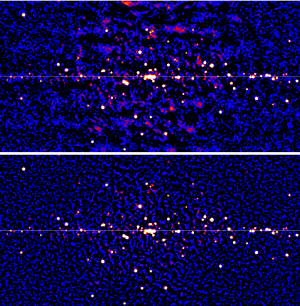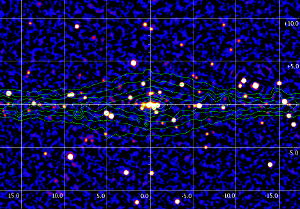 |
|
Fig. 1:
This map shows a region of the Galactic plane, obtained with the
IBIS/ISGRI-camera on board INTEGRAL, covering the 17-60 keV energy
band. In the galactic centre, the central area of the map, the total
exposure time is about 20 million seconds. The top image shows the
results when using a previous ("unimproved") sky reconstruction
method. The bottom image demonstrates how the sky image is enhanced
when using the improved method.
|
 |
 |
|
Fig. 2:
Enlarged image of the central area (galactic bulge region) in the
INTEGRAL/IBIS 7-year map. The overlaid brightness contours of the 4.9
micrometre COBE/DIRBE-image trace the Galaxy's old stellar population
and reveal the disk/bulge structure.
|
|  |
Recently, there has been great progress in surveying the sky at high
energies. Among the main gamma-ray missions currently in orbit are the
Burst Alert Telescope (BAT) of the NASA Swift observatory and the IBIS
telescope on board the ESA INTEGRAL spacecraft, which are both
covering large angles on the sky. The large sample of active galactic
nuclei (AGN) detected by the nearly uniform Swift/BAT all-sky survey
shows that this telescope is very valuable for extragalactic
studies. In contrast, the INTEGRAL observatory has non-uniform sky
coverage and provides a survey that is more sensitive in the Galactic
plane. This makes the Swift/BAT and INTEGRAL/IBIS surveys
complementary.
A copious amount of exposure time for the Milky Way galaxy, however,
represented a challenge for the scientists, as the growing exposure
time does not automatically mean a corresponding increase in
sensitivity. The scientists faced two main problems: The coded-mask
technique of the IBIS telescope — one of the few methods of hard X-ray
imaging — leads to a number of systematic effects, which
plague the observations and limit the sensitivity of the
instruments. This affects especially images along the Galactic Plane
and the crowded field of Galactic Centre. The second difficulty comes
from a strong, diffuse X-ray radiation emitted in the Galactic Plane,
the so-called Galactic Ridge emission
(see  Research Highlight March 2006
, Research Highlight March 2006
,  Research Highlight April 2006
, Research Highlight April 2006
,  Research Highlight August 2006),
which affects the sky reconstruction that is based on complex
background modelling. Research Highlight August 2006),
which affects the sky reconstruction that is based on complex
background modelling.
Scientists from the MPA have now provided a novel image analysis
algorithm, which was developed to improve the sensitivity of the IBIS
telescope. First, the new background model now takes the X-ray
background of the Galaxy into account. Second, the reconstructed sky
images were cleaned from systematic noise by using a special algorithm
based on discrete wavelets.
”By combining the sky images of about 50,000 individual observations,
carried out from 2002 to 2009, our group conducted a survey of the
Milky Way with unprecedented sensitivity in hard X-rays,“ says
Roman Krivonos, the MPA researcher who led the study. ”The
final sky mosaic allows for the first time to study the population of
faint accreting X-ray binaries in the Galaxy.“
These kinds of objects could not be seen in existing soft X-ray
surveys of nearby galaxies performed with the Chandra and XMM-Newton
space observatories. The new sample of compact, galactic sources,
detected in this INTEGRAL survey, now represents a prototype for
future compact source samples that will be detected by upcoming hard
X-ray missions in nearby galaxies.
Roman Krivonos, Sergey Tsygankov, Mikhail Revnivtsev, Eugene Churazov, Rashid Sunyaev
Related Links
 MPA sky reconstruction algorithm MPA sky reconstruction algorithm
 Interactive INTEGRAL map of the galactic bulge Interactive INTEGRAL map of the galactic bulge
 ESA Press Release: INTEGRAL completes the deepest all-sky survey in hard X-rays ESA Press Release: INTEGRAL completes the deepest all-sky survey in hard X-rays
Related Publications
Krivonos, R.; Revnivtsev, M.; Tsygankov, S.; Sazonov, S.; Vikhlinin,
A.; Pavlinsky, M.; Churazov, E.; Sunyaev, R.,
"INTEGRAL/IBIS 7-year All-Sky Hard X-Ray Survey — Part I: Image Reconstruction",
2010, A&A, Volume 519, id.A107
 http://dx.doi.org/10.1051/0004-6361/200913814 http://dx.doi.org/10.1051/0004-6361/200913814
Krivonos, R.; Tsygankov, S.; Revnivtsev, M.; Grebenev, S.; Churazov,
E.; Sunyaev, R.,
"INTEGRAL/IBIS 7-year All-Sky Hard X-Ray Survey. Part II: Catalog of Sources",
2010, A&A accepted
 http://arxiv.org/abs/1006.4437 http://arxiv.org/abs/1006.4437
|



